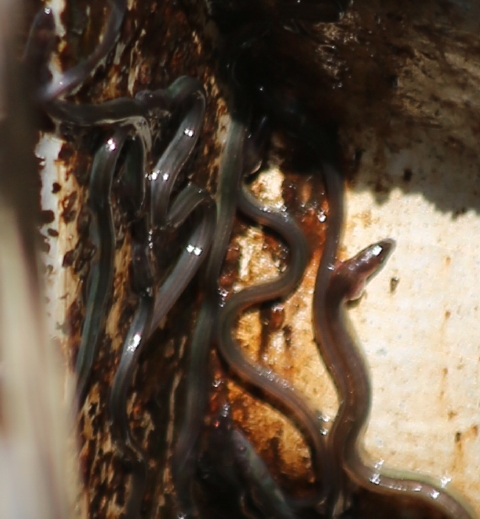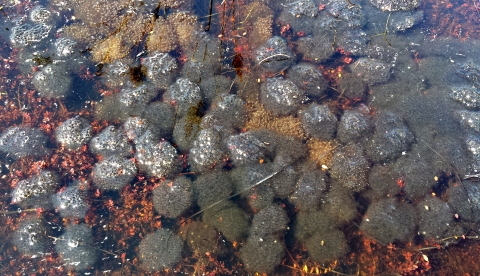Slightly Pigmented (American Eel) Elver (Anguilla rostrata)
The Turtle Journal team had an opportunity to play a role in the life cycle of American eels (Anguilla rostrata) this weekend, to learn a lot about tiny elvers, to document the huge challenges to their survival, to engage in some hands on field research and discovery, to save a few hundred juveniles and to work towards smoothing the journey for new generations of American eels within the SouthCoast watershed. Â Like so much else in the natural world, we humans hold the future of this species in our own hands, just as Sue Wieber Nourse holds a tiny elver in her hand as we lift it past an obstacle to its survival.Â
American Eels Spawn in the Sargasso Sea
The epic journey of the American eel (Anguilla rostrata) is a literal ocean odyssey with few equals in the marine world. Â American eels spend their lives in fresh water ponds and estuaries on the East Coast of North America. When the time comes, and eels can live long lives, mature adults leave the ponds where they spent their lives. Â They slither through bog, creek and river to reach an estuary as they begin their long, long ocean journey to the Sargasso Sea.
 IF YOU HAVE AN iPAD & CAN’T SEE VIDEO, CLICK HERE.
American Eel Life Cycle by GRYPHON Media Productions
[This brief video funded by Unamaki Institute of Natural Resources (Cape Breton) and Parks Canada provides an excellent overview of the life cycle of the American eel (Anguilla rostrata).]
It’s a one way trip. Â Adults will consume all their energy stores to produce and externally fertilize eggs in a giant spawning in the Sargasso Sea. Â Each female can lay millions of eggs and dies after egg laying. Â When hatched, the larvae develop into leptocephali and float in the currents like tiny leaves, ever moving closer to North American shores where they metamorphose into glass eels. Â As they enter estuaries and fresh water systems, they develop pigment and become elvers.
Tiny American Eel Elvers Scale 10-Foot Water Control Device
In this epic journey from Sargasso Sea in the middle of the Atlantic Ocean to a local SouthCoast pond, elvers must traverse enormous challenges, the most serious being obstacles erected by human development: Â dams, hydro-power systems, water control regimes, fast flowing culverts, flood control devices and so on. Â After a perilous trek of thousands of miles from the mid Atlantic ocean, tiny vulnerable elvers get stopped within inches of their goal by human contraptions for which evolution never prepared them. Â And that might be the journey’s tragic end were it not for their extraordinary tenacity and persistence … augmented with a critical assist from caring and knowledgeable locals. Â One such local planner called Turtle Journal on Friday, May 16th, to report that elvers had been sighted at a SouthCoast cranberry bog as they were trying to scale a 10-foot vertical water control device.
Hundreds of Tiny Elvers Squiggle Straight Upward
On Saturday morning we visited the bog and found hundreds of tiny elvers wriggling up the vertical 10-foot device in an attempt to reach the fresh water pond where they would spend their lives.
IF YOU HAVE AN iPAD & CAN’T SEE VIDEO, CLICK HERE.
American Eel Elvers, May 2014
We documented the process, and later spoke with the bog operator about potential assists to facilitate the elvers’ passage through the water control device. Â Years ago the bog operator had constructed a concrete and rock “ladder” with continuous water flow leading from the creek to the pond. Â We observed many elvers using this passage to reach the pond.
Tiny American Eel Elver and Don Lewis’ Thumb for Sizing
While no longer glass eels because they have become somewhat pigmented while moving through estuary and creek, the overwhelming number of elvers were quite small as indicated by the photograph above with a Don Lewis’ thumb to gauge sizing.
~ Eighteen Inch American Eel Climbs Ladder into Pond
As we watched the concrete “ladder,” a large (~ 18 inch) American eel slithered up the stairs. Â We suspect that at this stage of development it would be called a yellow eel.
~ Eighteen Inch American Eel Slithers into Pond
After climbing the concrete “ladder,” the eel slipped into the pond and lazily powered itself into deeper waters. Â During the two hours we observed this ladder, elvers of various sizes and stages of development made the passage from creek to pond. Â First, they scaled a six foot tight rocky passage, then they completed the transition by climbing the wet concrete stairs.
Thousands of Elvers Obstructed by Newly Installed Culvert
Saturday night we pored over watershed maps to trace the path from the bog to Buzzards Bay through Aucoot Cove and associated creeks, streams and bogs. Â We identified the likely pathway for the elvers and highlighted a potential obstacle to their passage. Â On Sunday we visited the site of the potential blockage, and Sue Wieber Nourse observed thousands of elvers backed up by a newly installed, gushing culvert.
1/2 Gallon Pail Yields ~ Hundred Obstructed Elvers
How many elvers were frustrated by the new culvert? Â We dipped a half gallon pail into the creek and quickly pulled it out. Â In that brief instant, a hundred tiny elvers flooded into the half filled pail. Â We contacted the planner for the site immediately, alerted him to the situation and talked about potential quick and long term fixes.
A Boost for a Hundred Elvers
Alas, we still had our 100 elver bucket. Â It reminded me of the story of the old man (or sometimes a young girl) and a beach full of starfish. Â If you’d like to read a version of this story, click here. Â Yes, we couldn’t help every elver make that passage from creek to pond. Â But we sure could give a huge boost to the 100 elvers in our plastic sampling bucket. Â If just one or two or five or ten of those 100 elvers made it back to the Sargasso Sea and laid millions of eggs … Well, perhaps our quixotic gesture wasn’t as foolish as we originally thought. Â In fact, since we’re saving the world one turtle at a time, maybe we can save the world one yellow elver bucket at a time, too. We lugged the bucket across the trail to the pond and poured 100 elvers into their new home.

























